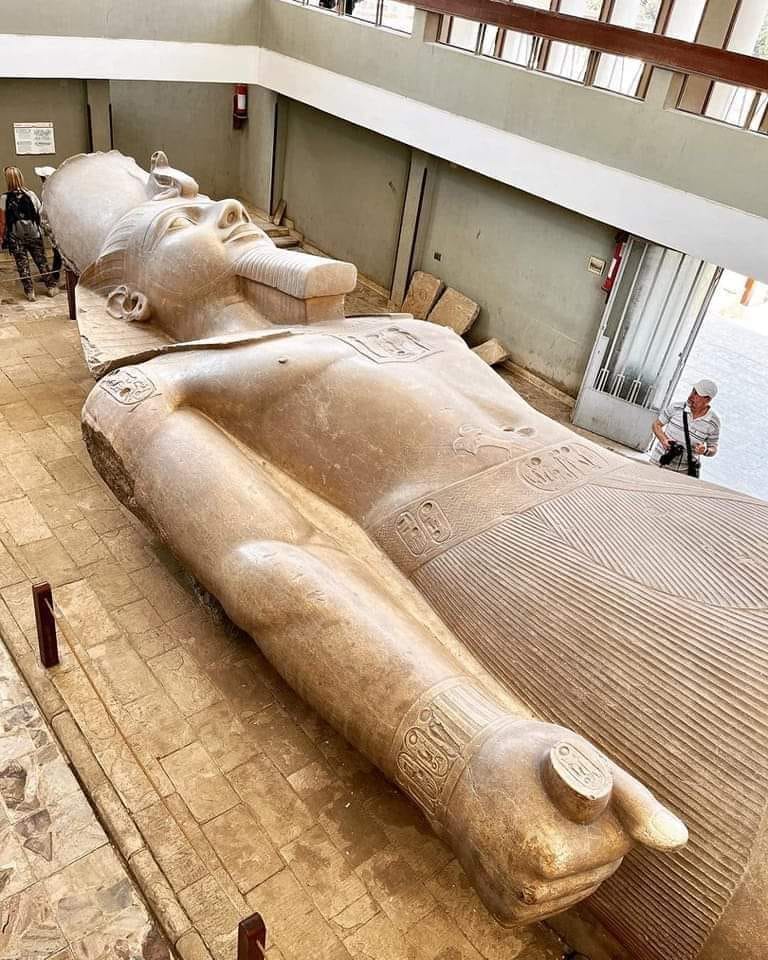In the heart of ancient Memphis, nestled within the cradle of Egyptian civilization, lies a breathtaking marvel that speaks volumes about the grandeur and ambition of one of history’s most formidable rulers. It is not merely a statue—it is a timeless tribute to the enduring legacy of Ramesses II, a pharaoh whose name still echoes through the annals of history. This colossal figure, carved from a single, massive block of limestone, represents not only a physical feat of ancient craftsmanship but also a powerful symbol of divine kingship, military prowess, and religious devotion. Though the statue now rests in a horizontal position, its original upright form once towered above onlookers at over 10 meters tall, a commanding presence meant to impress and intimidate.

What remains today is a testament to the scale and ambition of the man it honors. Known as Ramesses the Great, this ruler reigned for more than 60 years during Egypt’s 19th Dynasty, a period marked by political stability, expansive building projects, and far-reaching military campaigns. His image, frozen in stone with meticulous attention to detail, reflects not just his physical appearance, but the powerful persona he projected across the ancient world. The face of the statue—stern yet regal, commanding yet calm—captures the authority of a leader who viewed himself not just as a man, but as a living god, chosen by the divine to rule over the land of the Nile.
The craftsmanship evident in the statue’s design speaks to the extraordinary skills of the ancient artisans who worked with tools rudimentary by modern standards, yet achieved results that continue to astonish. The facial features are symmetrical and finely sculpted, the headdress carefully proportioned, and even the muscles of the torso convey strength and vitality. Every curve and line was purposefully etched, not simply to depict a human figure, but to immortalize a ruler in his prime—powerful, immortal, and everlasting.
What makes this monument even more valuable is the presence of hieroglyphic inscriptions that cover parts of the statue’s surface. These intricate carvings function much like a diary written in stone, offering insight into the accomplishments and worldview of Ramesses II. The hieroglyphs extol his lineage, linking him to the gods, and recount his victories on the battlefield and his generous contributions to religious institutions. They describe his divine favor, his role as protector of Ma’at—the cosmic order—and his devotion to Amun, the king of gods. For archaeologists and historians, these inscriptions are an invaluable resource, offering a rare and direct glimpse into the mindset and priorities of an ancient ruler who sought not only to govern but to shape the future’s memory of his reign.
The story of this statue’s rediscovery adds another layer of intrigue to its legacy. Unearthed in 1820 near the ruins of Memphis by the Italian explorer Giovanni Battista Caviglia, the colossus immediately captivated the world. Its immense size and near-complete preservation stunned both scholars and the public, reigniting interest in Egypt’s ancient past and helping to fuel the burgeoning field of Egyptology. In a time when Europe was gripped by fascination with classical antiquity, the statue served as a striking reminder that Egypt, too, had once been a center of unrivaled cultural and political power.
Even in its current state—lying on its back rather than standing tall—the statue continues to convey a sense of awe. Its resting pose invites viewers to pause and reflect, not just on the man it commemorates, but on the civilization that produced such enduring works of art. It is a reminder that ancient Egypt was more than myths and pyramids; it was a society rich in architectural achievement, artistic excellence, and spiritual complexity. The fact that the statue still inspires wonder centuries after its creation is a powerful testament to the enduring nature of human creativity and ambition.
The monument has also become an important cultural symbol for modern Egyptians, serving as a tangible connection to their ancestral heritage. Tourists from around the world travel to witness this masterpiece, often standing in silent reverence before the sleeping giant, contemplating the hands that carved it and the world it once dominated. For many, it evokes a sense of continuity—a bridge between the ancient past and the present, reminding us that while empires may rise and fall, the marks they leave behind can still inspire and educate.
Standing before this monumental work, one cannot help but be transported back to an era when the boundaries between the mortal and the divine were blurred, when rulers saw themselves as chosen by the gods, and when art was not merely decorative but deeply symbolic. The statue does not merely depict a pharaoh; it enshrines an ideal. Ramesses II, through this colossal creation, sought immortality not only in the afterlife but in the memory of mankind. And in that pursuit, he has clearly succeeded.
Today, the statue rests within the Ramesses II Museum in Mit Rahina, protected and preserved so future generations can appreciate the brilliance of a bygone age. While time has eroded some of its finer details, its essence remains intact—majestic, powerful, eternal. For anyone standing before it, the experience is more than just historical; it is deeply human. It stirs the imagination, raises questions about the nature of power, legacy, and memory, and leaves us pondering the stories that will one day be told about our own time.
In every respect, this magnificent monument fulfills its original purpose: to honor a ruler who sought to transcend time. Ramesses II may have passed into the annals of history, but through this limestone leviathan, his vision, ambition, and legacy continue to speak across the centuries. It is a voice from the past that still has much to say—a silent, sleeping giant that continues to awaken the curiosity and admiration of all who stand in its presence.





